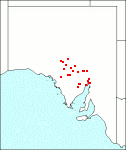Family: Asteraceae
Angianthus glabratus
Citation:
P. Short, Muelleria 5:162 (1983).
Synonymy: Not Applicable Common name: None
Description:
Annual herb 4-15 cm high; stems several from the base, ascending or erect, branched, glabrous to cobwebby, sometimes densely so near the apex; leaves alternate, succulent, terete, linear, obtuse, 0.4-2.8 cm long, c. 1 mm wide, glabrous, green.
Compound heads ellipsoid to cylindrical, 1-3 cm long, 4-6 mm diam., with 100-500 capitula; common involucral bracts few, c. 2 mm long, not enclosing the broad base of the inflorescence; bracts subtending capitula solitary, rarely 2 or 3 overlapping, ovate to oblong, 1.8-2.5 mm long, glabrous or the midrib hairy near the apex; capitular involucral bracts 1.6-2.4 mm long, with midribs glabrous or hairy near the apex, the inner pair gradually attenuate near the base; corolla evenly tapered, 5-toothed, 1.1-1.5 mm long.
achene obovoid, 0.5-0.8 mm long; pappus a jagged scarious cup 0.2-0.4 mm high, sometimes partly divided into c. 5 scales.
|
|
Distribution:
|
Occurs among succulents on the margins of saline depressions, also on coastal and inland sand dunes.
S.Aust.: GT, EP.
|
Conservation status:
native
Flowering time: Sept. — Nov.
|

SA Distribution Map based
on current data relating to
specimens held in the
State Herbarium of South Australia
|
Biology:
Closely related to A. conocephalus and A. brachypappus; the 3 species have adjacent but distinct geographical ranges.
Author:
Not yet available
|

